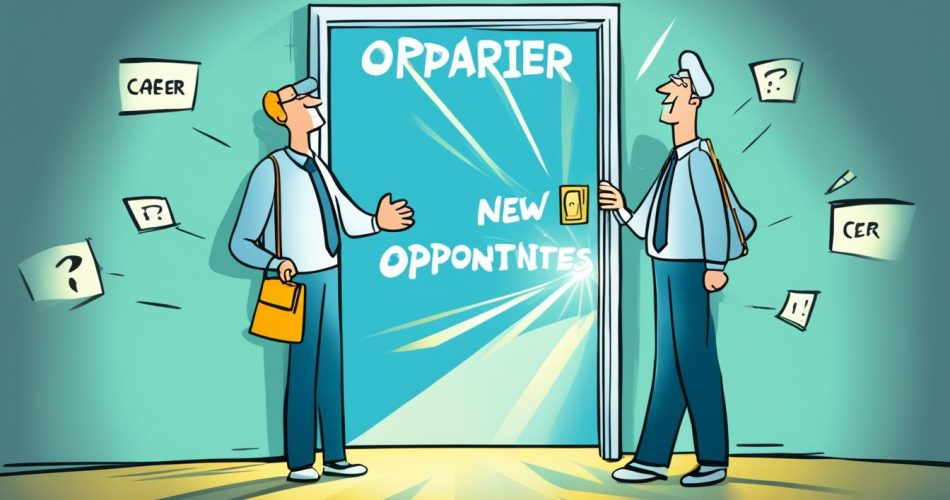Transitioning back into the workforce after a career break can be challenging, but it doesn’t have to be overwhelming. As I navigate my own job search after taking a break, I’ve discovered helpful strategies to increase my chances of finding the right job opportunity. Whether you’re reentering the workforce after a break or looking to make a career transition, these tips will guide you towards a successful comeback.
Returning to work can feel daunting, especially if it has been a while since you’ve been in the job market. But with the right job search strategies and a positive mindset, you can find meaningful employment after a career gap or sabbatical. Here’s what I’ve learned along the way:
Reentering the Workforce
When reentering the workforce after a break, it’s important to ease back in and not rush into the first job you find. Consider taking refresher courses, volunteering, or doing freelance work to update your skills and gain experience. Use this time to explore your interests and passions, and don’t be afraid to pursue a new career path that truly fulfills you.
Activate Your Network
Your network can be a valuable asset when it comes to finding job opportunities. Reach out to people who know you well and ask for their support and introductions. Offer to draft introduction emails to make it easier for them to assist you. Additionally, connect with individuals in your network who can vouch for your skills and work ethic. Networking can open doors to hidden job opportunities and increase your chances of finding a job that aligns with your interests and goals.
Match Transferable Skills
Don’t underestimate the value of your transferable skills. Identify the skills you have acquired in your previous work experience that can be applied to different positions and industries. Align these skills with the job descriptions of the positions you’re interested in. Emphasize these skills on your resume and LinkedIn profile, and seek feedback from friends and colleagues to gain new perspectives on how your skills can be valuable in your desired field.
Tell A Compelling Story
Craft a compelling narrative that showcases your unique strengths and experiences. Prepare yourself with key points or stories that highlight your relevant skills and accomplishments during interviews. Be clear about your career goals and why the position aligns with your interests and values. Tailor your story to match the job description and demonstrate your commitment to professional growth. Practice and refine your storytelling skills to make a memorable impression on hiring managers.
Key Takeaways:
- Take your time when reentering the workforce to explore new career paths and update your skills.
- Activate your network and leverage connections to discover hidden job opportunities.
- Identify and highlight your transferable skills to showcase your value to potential employers.
- Craft a compelling story that aligns your career goals with the position you’re applying for.
- Practice and refine your storytelling skills to make a lasting impression during interviews.
Reentering the Workforce
When reentering the workforce after a break, it’s important to ease back in and not rush into the first job you find. This transition period presents an opportunity for growth and exploration, allowing you to redefine your career path and pursue what truly fulfills you. Here are some strategies to help you make a successful comeback:
- Update your skills: Consider taking refresher courses, attending workshops, or participating in online training programs to stay up-to-date with industry trends. This will not only enhance your expertise but also demonstrate your commitment to professional development.
- Gain experience: Engage in voluntary work, freelance projects, or internships to acquire practical experience and fill any gaps in your resume. This hands-on involvement will not only sharpen your skills but also provide valuable references for future job applications.
- Highlight your achievements: During interviews, briefly explain your career break and emphasize any skills or achievements gained during that time. This could include successfully completing personal projects, acquiring new certifications, or even developing transferable skills through community involvement.
Use this opportunity to reboot your career and embrace new possibilities. Remember, reentering the workforce is a chance for growth, reinvention, and finding a job that aligns with your true passions and aspirations.
Activate Your Network
When it comes to finding job opportunities, sometimes it’s not just about what you know, but who you know as well. That’s why activating your network is a crucial step in your job search strategies. By leveraging the power of your connections, you can gain access to hidden job opportunities and increase your chances of finding the perfect job that aligns with your interests and goals.
Connecting with people who already know you well can be a great starting point. Reach out to friends, family, former colleagues, and mentors, and let them know that you are actively looking for a job. Ask for their support, introductions, and any advice they might have. Building relationships with people who already trust and respect you can open doors to job referrals and recommendations.
Make it easy for your network to assist you. Offer to draft introduction emails for your connections, making it effortless for them to introduce you to potential employers or contacts in your desired industry. By taking this proactive approach, you increase the likelihood of them helping you connect with the right people who can further your job search.
Additionally, don’t forget to tap into the power of networking events and online platforms. Attend industry conferences, job fairs, and professional meet-ups to expand your network. Participate in online communities, such as LinkedIn groups or industry-specific forums, to engage with like-minded professionals and showcase your expertise.
Nurturing Your Network
Building a network is not just about asking for favors. It’s about fostering mutually beneficial relationships and demonstrating your value to others as well. Take the time to engage with your connections, offer your support, and share relevant insights or resources. By becoming a valuable member of your network, you increase the likelihood of receiving job referrals and recommendations in return.
Remember, networking is not just about getting something from others; it’s about building meaningful connections that can benefit both parties involved.
Lastly, don’t underestimate the power of reaching out to individuals who can vouch for your skills and work ethic. These could be former colleagues, supervisors, or clients who have witnessed your capabilities firsthand. Ask them if they would be willing to provide a testimonial or referral to potential employers. Having someone back your abilities and speak highly of your professional attributes can give you a competitive edge in the job market.
By activating your network, you tap into a valuable resource that can significantly boost your job search efforts. Leverage the power of your connections, nurture those relationships, and always be open to new opportunities. Remember, networking is not just about finding a job; it’s about building a strong professional community that supports your career growth.
Match Transferable Skills

When transitioning to a new career or reentering the workforce after a break, identifying and leveraging your transferable skills is crucial. These skills, acquired through previous work experiences, can be applied to different positions and industries, making you a valuable candidate. Here are some examples of transferable skills:
- Leadership: Demonstrated ability to lead and motivate teams.
- Communication: Excellent written and verbal communication skills.
- Problem Solving: Strong analytical and critical thinking abilities.
- Adaptability: Able to thrive in fast-paced and ever-changing environments.
- Organizational Skills: Efficiently manage time, resources, and projects.
When searching for job opportunities, carefully review the job descriptions and requirements to identify the specific transferable skills sought after by employers. Highlight these skills on your resume and LinkedIn profile, and showcase them during interviews. It’s also beneficial to seek feedback from friends and colleagues to gain new perspectives on how your transferable skills can be valuable in your desired field.
Comparison of Transferable Skills
| Skills | Industry A | Industry B | Industry C |
|---|---|---|---|
| Leadership | High | Medium | Low |
| Communication | High | High | Medium |
| Problem Solving | High | High | High |
| Adaptability | Medium | High | Medium |
| Organizational Skills | High | High | High |
By matching your transferable skills with the requirements of your desired job, you can effectively position yourself as a capable and qualified candidate. Emphasize your transferable skills and their relevance to the position, demonstrating your ability to contribute to the success of the organization and smoothly transition into a new career.
Tell A Compelling Story

In today’s competitive job market, it’s crucial to go beyond simply listing your qualifications on a resume. To stand out from the crowd and make a lasting impression on hiring managers, you need to tell a compelling story that showcases your unique strengths and experiences. Crafting a personal brand narrative can help you create an emotional connection with potential employers and demonstrate your value as a candidate.
During job interviews, seize the opportunity to share five key points or stories that highlight your relevant skills and accomplishments. These stories should not only demonstrate your expertise but also reflect your character and personality. By weaving your personal brand narrative into these stories, you’ll leave a memorable impression on hiring managers and differentiate yourself from other candidates.
When crafting your narrative, be clear about your career goals and explain why the position aligns with your interests and values. Tailor your story to match the job description, highlighting how your experiences and skills are a perfect fit for the role. This customized approach not only shows your attention to detail but also showcases your commitment to professional growth.
Remember that storytelling is a skill that can be honed and perfected. Practice your storytelling techniques to ensure a smooth and engaging delivery during your interviews. Pay attention to the feedback you receive and continuously refine your narrative to make it more compelling and impactful.
“I always found that anecdotes about accomplishments and experiences are much more effective than just listing skills on a resume. It gives me the opportunity to connect with the interviewer on a personal level and showcase my unique value as a candidate.” – Mark Johnson, Job Seeker
Elements of a Compelling Narrative
| Element | Description |
|---|---|
| Hook | An attention-grabbing opening that captivates the listener. |
| Relevant Skills | Highlight the skills that are applicable to the position you’re interviewing for. |
| Accomplishments | Showcase your achievements and demonstrate how they can contribute to the company’s success. |
| Challenges | Share how you’ve overcome obstacles and demonstrate your resilience. |
| Passion | Express your enthusiasm for the industry and the role you’re applying for. |
By incorporating the elements shown in the table above, you can create a powerful and persuasive narrative that highlights your skills, experiences, and passion. Remember, storytelling is not only reserved for job interviews but can also be a valuable tool throughout your career to leave a lasting impression and build meaningful connections.
Conclusion
Transitioning back into the workforce after a career break or sabbatical can be a challenging journey. However, with the right strategies and mindset, you can successfully reenter the job market and find a fulfilling opportunity. By leveraging your transferable skills, activating your network, and crafting a compelling personal story, you can showcase your unique value and stand out to potential employers.
Throughout this process, it is important to prioritize your mental well-being. Job hunting after a break can sometimes be disheartening, but remember to be patient with yourself and stay positive. Stay focused on your career goals and maintain a growth mindset. With perseverance and determination, you can overcome any challenges and find a job that aligns with your passions and aspirations.
Returning to work after a break is an opportunity for personal and professional growth. Embrace this new phase of your career with confidence. Take proactive steps to update your skills, network with others, and stay up-to-date with industry trends. Remember, your career re-entry is a chance to shine and show the world your capabilities. Transitioning back into the workforce is your time to thrive.
FAQ
How can I transition back into the workforce after a career break?
To transition back into the workforce after a career break, consider taking refresher courses, volunteering, or doing freelance work to update your skills and gain experience. In interviews, briefly explain your career break and highlight any skills or achievements gained during that time. Use this opportunity to reboot your career and pursue what fulfills you.
How can I leverage my network to find job opportunities?
Leverage your network by reaching out to people who know you well and asking for their support and introductions. Make it easy for them to assist you by offering to draft introduction emails. Also, connect with individuals in your network who can vouch for your skills and work ethic. Networking is an effective way to access hidden job opportunities and increase your chances of finding a job that aligns with your interests and goals.
What are transferable skills and how can I highlight them?
Transferable skills are skills acquired in previous work experience that can be applied to different positions and industries. To highlight transferable skills, align them with the job descriptions of the positions you’re interested in. Make sure to emphasize these skills on your resume and LinkedIn profile. Seek feedback from friends and colleagues to gain new perspectives on how your skills can be valuable in your desired field.
How can I tell a compelling story during job interviews?
Craft a compelling narrative that showcases your unique strengths and experiences. Prepare yourself with key points or stories that highlight your relevant skills and accomplishments. Be clear about your career goals and why the position aligns with your interests and values. Tailor your story to match the job description and demonstrate your commitment to professional growth. Practice and refine your storytelling skills to make a memorable impression on hiring managers.
What advice do you have for transitioning back into the workforce?
Transitioning back into the workforce may have its challenges, but with the right strategies and mindset, you can successfully reenter the job market. Take advantage of your transferable skills, activate your network, and tell a compelling story that showcases your unique value. Remember to maintain your mental well-being throughout the process and be patient with yourself. With perseverance and determination, you can find a fulfilling job opportunity that aligns with your career goals.

